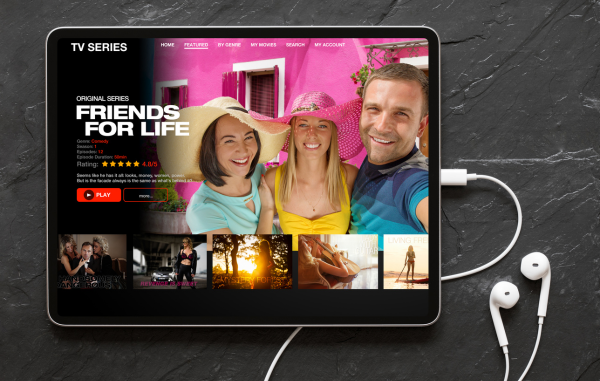

Digitisation and the advancement of digital technologies have always posed a significant threat to conventional media and entertainment models. Digital downloads killed both Block Buster (in the US) and Musica (in South Africa) which were both major brands.
One of the brands that took the potential threat of digitisation seriously was Netflix. Originally a vending machine that dispensed video tapes and DVDs, the company invested significantly in building one of the world’s first streaming services. Many other companies followed suit and were rewarded during the COVID-19 pandemic, during which lockdowns and social distancing forced the public onto these platforms.
What impact will this have on conventional media models in the future?
The Impact of Streaming Services on the Entertainment Industry
The article points out that the entertainment industry has undergone a seismic shift in recent years as streaming services have disrupted traditional distribution models and transformed the way content is consumed.
On-demand and personalised content. Streaming services like Netflix and Spotify have revolutionised how people consume entertainment by offering on-demand access to a vast library of content. This has empowered consumers to curate their own entertainment experiences, choosing what, when, and how they want to watch or listen to content. Traditional television and radio networks have struggled to compete with this level of choice and personalisation.
Original content and creative freedom. Streaming services have invested heavily in producing original content, giving rise to a new era of creative storytelling. This has created opportunities for emerging filmmakers, writers, and artists to showcase their work and reach a global audience. Companies like Netflix and Amazon Studios have disrupted the traditional studio model by providing creators with more creative freedom and bypassing traditional gatekeepers.
Disintermediation and direct-to-consumer distribution. The article adds that streaming services have disrupted the traditional distribution model by connecting content creators directly with consumers. This disintermediation has reduced barriers to entry for independent content creators and has given them a platform to reach a global audience. It has also allowed consumers to discover and support niche content that may not have found a place in traditional distribution channels.

Image By: Canva
The impact of streaming services on music
The article points out that in today’s rapidly evolving digital music landscape, streaming services have become a dominant force, revolutionising the way we consume and discover music. As a result, the impact of streaming services on breakout singles cannot be understated. These platforms have not only provided artists with unprecedented access to a global audience but have also reshaped the very nature of what constitutes a breakout single. In this section, we will delve into the various ways in which streaming services have influenced the success and popularity of breakout singles, exploring both the positive and negative implications.
Global Reach and Exposure. The article adds that one of the most significant advantages of streaming services is their ability to connect artists with a vast and diverse audience worldwide. Unlike traditional radio or physical sales, which were often limited by geographical boundaries, streaming platforms offer instant access to music for users across the globe. This global reach has undoubtedly contributed to the increased visibility and potential breakout success of singles. For example, breakout singles like “Despacito” by Luis Fonsi and Daddy Yankee reached billions of streams worldwide, propelling them to international stardom.
The impact of streaming services on traditional television networks
The article points out that streaming services have revolutionised the way we consume content, particularly television shows. With the rise of platforms like Netflix, Hulu, and Amazon Prime Video, traditional television networks are facing unprecedented challenges. This section will delve into the impact of streaming services on these networks, exploring different perspectives and providing in-depth insights on the matter.
Diversification of Content. One of the key advantages of streaming services is the wide range of content they offer. Unlike traditional television networks that adhere to strict programming schedules, streaming platforms provide a vast library of shows and movies that can be accessed anytime, anywhere. This has led to a diversification of content, catering to a broader range of interests and preferences. For instance, while traditional networks may focus on mainstream shows, streaming services have embraced niche genres, foreign-language series, and independent productions, giving viewers a more personalised and diverse viewing experience.
Changing Viewership Patterns. Streaming services have significantly altered viewership patterns, with many people opting to “cut the cord” and rely solely on streaming platforms for their entertainment needs. This shift in behaviour has led to a decline in traditional television viewership, as audiences now have the freedom to choose what, when, and how they watch their favourite shows. Furthermore, the ability to binge-watch entire seasons or series at once has become a popular trend, allowing viewers to consume content on their own terms.
Disruption of Advertising Model. Traditional television networks heavily rely on advertising revenue to sustain their operations. However, streaming services have disrupted this model by offering ad-free or limited-ad options. This has attracted viewers who prefer uninterrupted viewing experiences, but it has also posed challenges for networks that heavily rely on ad revenue. As a result, traditional networks are exploring new ways to incorporate advertising into their programming, such as product placements or sponsored content.

Image By: Canva
Porters Five Forces
It is important to note that the rise of streaming services and their threat to conventional media models should not surprise companies. Porter’s Five Forces clearly shows that technology will simplify processes, and companies that use it will reap significant benefits.
Those who ignore it will become increasingly irrelevant to the point that they will be underperforming companies within thriving markets.
There are two immediate actions that companies can implement to improve their performance.
The first action is to look at the content they already own and how they can use it to their advantage. One of the essential tactics that streaming services are using at the moment is that they are investing heavily in original content. The South African Broadcasting Service (SABC) has a treasure trove of localised content that can be shifted onto a streaming platform. They don’t even have to make a significant investment in producing this content and won’t have to pay royalties to acquire it.
The second significant action point is to reassess the packaging and pricing of this content. Multichoice is losing subscribers rapidly, yet the company’s monopoly on sports production is one of the main reasons the company still has a significant following. There have long been calls for a DStv package focusing on sport. Multichoice needs to be first to market in South Africa before the likes of Paramount +, which has broadcast rights for the Indian Premier League (cricket), the Barclays Premier League (football) and all of the Major Golf tournaments, capture significant market share.




